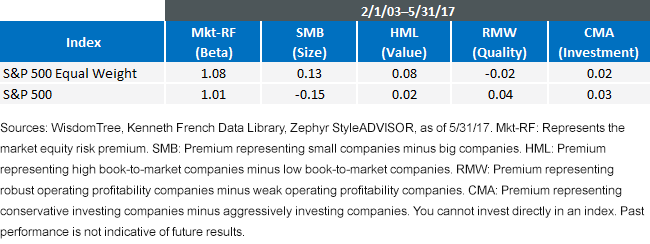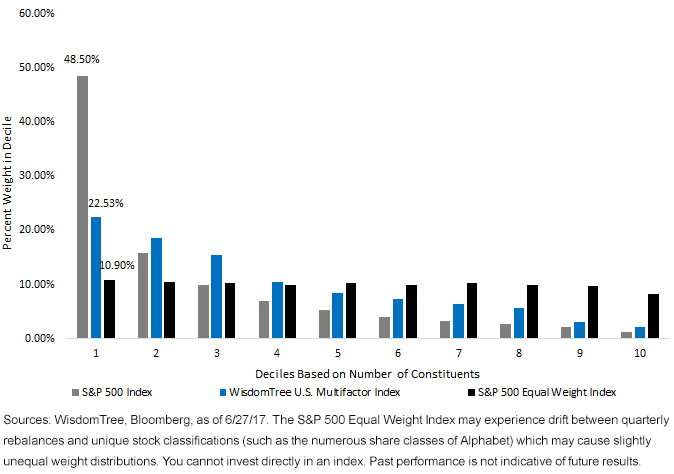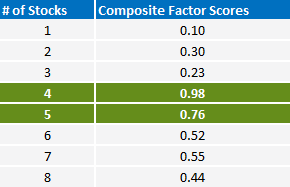The WisdomTree U.S. Multifactor Index: Watch Your Weight



When reading through your daily dose of smart beta literature, you will find some who believe equally weighting an index is a smart beta approach and some who don’t. We believe the necessary question is, “Does equal weighting provide exposure to a factor or an academically proven source of excess return?” The answer to that question is a resounding yes.
Size, or the idea that smaller companies provide excess return compared with larger companies over time, was one of the core tenets of Fama and French’s original research. Below we see how the S&P 500 Equal Weight Index, since its first full month of live data, flipped the size factor loading of these 500 stocks from negative to positive, indicating a now positive movement with Fama and French’s size premium. This result is intuitive, as equal weighting reduces the weight of the higher market cap stocks while simultaneously increasing it to smaller-cap stocks, relative to market cap weighting.
Figure 1

Because equal weighting provides access to size, the question then becomes, what do the results look like versus the S&P 500 Index market cap weighted over a full market cycle or longer?
Figure 2

The S&P 500 Equal Weight Index outperformed the S&P 500 Index by an average of more than 200 basis points (bps) per year, over almost 15 years. And while it did have higher volatility compared to the S&P 500, it did so with a higher Sharpe ratio. Similarly, while it experienced meaningful tracking error compared to the S&P 500, it did so with a meaningfully high information ratio. In short, through the lens of smart beta exposures and the size factor, equal weighting worked.
The WisdomTree U.S. Multifactor Index and Modified Equal Weighting
Our new WisdomTree U.S. Multifactor Index selects companies based on four factors: quality, value, momentum and low correlation. One may wonder why we excluded size. Well, in our view, we didn’t. We gain exposure to the size factor by virtue of how we weight constituents.
The chart below shows aggregated constituent weights of the S&P 500, the WisdomTree U.S. Multifactor Index, and the S&P 500 Equal Weight Index as of June 27, 2017. We broke the data into deciles, so the first decile represents the index weight that is allocated to the largest 10% of constituents. For the S&P indexes, this is roughly the top 50 stocks, while for the WisdomTree Index, which consists of 200 stocks, the first decile represents the top 20.
Figure 3: Index Weight Distribution as of 6/27/17

The largest difference in the chart above is in the first decile, where the S&P holds almost half of its entire weight. The WisdomTree U.S. Multifactor Index, however, looks and feels much more like equal weighting; that is, it more evenly distributes weight among the different deciles. This relationship provides our Index with size exposure and leads us to believe that while not being equal weighted exactly, it achieves a form of modified equal weighting. To put that into greater perspective, as of this writing, the new WisdomTree Index encompasses nearly $8 trillion of combined market cap, with about 41% of the Index weight belonging to mid-cap companies. Let’s explore how exactly it’s modified and why we think it adds value to the WisdomTree U.S. Multifactor Index beyond just providing size exposure.
How the WisdomTree U.S. Multifactor Index Weights
To frame our discussion, let’s begin with acknowledging that the WisdomTree U.S. Multifactor Index weights each stock based on two metrics:
- Half Volatility Score
Let’s first investigate the half CFS weighting, the cornerstone of the modified equal-weighting approach.
WisdomTree ranks 800 stocks by each factor and then assigns a CFS to each, measuring a stock’s combined exposure to value, quality, momentum and low correlation. Using this system, 1 would be the best CFS while 0 would be the worst. From there, we select the top 200 stocks by this score to be included in the Index.
We consider a higher CFS to mean stronger and more diversified factor exposure and thus a higher probability to generate alpha. Due to our high conviction in our alpha signals, we naturally wanted to go beyond using it as just a selection, also incorporating it into stock weighting. Therefore, we tilt to stocks with higher Composite Factor Scores and tilt away from stocks with lower Composite Factor Scores.
As an example, let’s use a universe of 8 stocks instead of 800, and select 2 stocks instead of 200.

When you select only the top 200 Composite Factor Scores between 0 and 1, you end up with stocks that have similar, high Composite Factor Scores. Looking at our example, stocks 4 and 5 both have scores over .75, well above the rest of the universe. If we used 200 stocks instead of 2, numbers like .98, .95 or .93 would receive little weight differences, leading to the equal-weighted feel shown in figure 3.
This CFS weighting system accounts for only half of the weight, however.
The other half of weighting considers each of these stocks trailing 12-month volatility, tilting this alpha-oriented basket more to those companies that we believe may provide higher risk-adjusted returns going forward.
Conclusion: Four Factors through Selection, but Six through Weighting
The equal-weighted nature of selecting only the top 200 companies with the highest CFS and attributing half of each stock’s weight to that CFS exposes the WisdomTree U.S. Multifactor Index to an additional factor: size, which is an important long-term driver of excess return. Weighting by half low volatility then takes these alpha-selected stocks and tilts toward those with less volatility historically, thus providing higher potential for superior risk-adjusted returns.
An important final step, which will not be discussed at length in this post, is that we then adjust these final weights one more time to be sector neutral compared to the market, helping to ensure potential alpha is achieved through diversified factor-based selection and weighting rather than large sector bets.
In short, we believe in equal weighting but we also believe in our diversified factor signal and in risk-adjusted returns. In this way, we believe WisdomTree has managed to have its cake and eat it too, maintaining both a return/risk-focused weighting system while also capitalizing on the benefits of an equally weighted approach.
Important Risks Related to this Article
Diversification does not eliminate the risk of experiencing investment losses.


